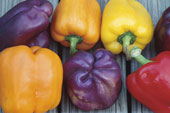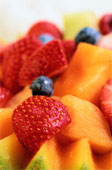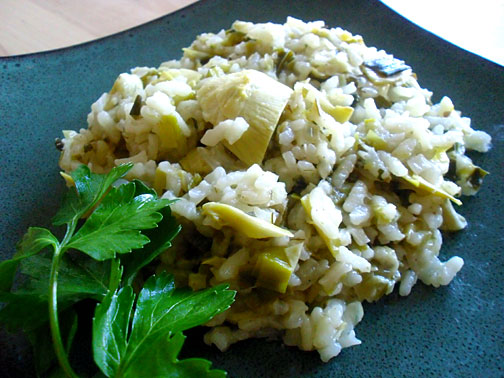
Risotto with Artichokes and Leeks
This week’s menu:
- Hearty Fish Chowder and Carrot Raisin Salad
- Seven-Vegetable Pasta with Tarragon Glaze and Chicken and Sweet Pea Soup
- Greek Style Turkey Patties with Lemon Tahini Dressing and Green Salad with Tomatoes and Cucumber
- Lentils with Sweet Potatoes and Spinach and Wild Mushroom and Walnut Rice
- Risotto with Artichokes and Leeks with Chicken and Broccoli Cauliflower Bisque
Vegetarian Menu options:
- Hearty Quinoa and Veggie Chowder and Carrot Raisin Salad
- Seven-Vegetable Pasta with Tarragon Glaze and Almonds and Sweet Pea Soup
- Falafel Patties with Lemon Tahini Dressing and Green Salad with Tomatoes and Cucumber
- Lentils with Sweet Potatoes and Spinach and Wild Mushroom and Walnut Rice
- Risotto with Artichokes and Leeks with White Beans and Broccoli Cauliflower Bisque
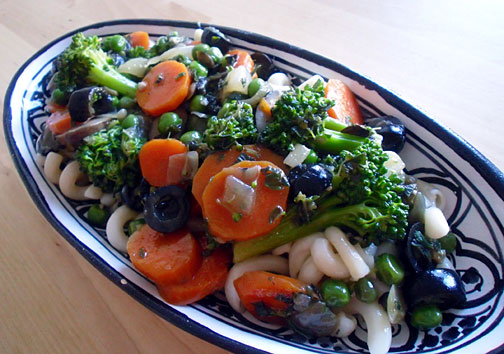
Seven-Vegetable Pasta with Tarragon Glaze
This week’s menu planner is full of savory and delicious dishes, that are easy to make and should take no more than 30 minutes to prepare. They are also very versatile – you can add chicken or fish or even beans or lentils to the dishes to fit your needs.
The Hearty Fish Stew is especially delicious – and I gave some to my son as well and he loved it. The little bit of rice flour and almond milk makes it creamy and the nutmeg adds a savory flavor. Enjoy!
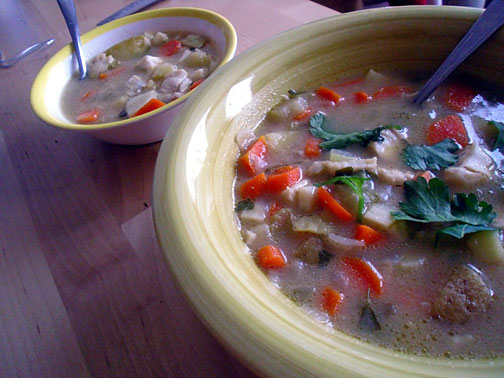
Hearty Fish Chowder- mama and baby bowls
Hearty Fish Chowder
Ingredients:
1 tablespoon olive oil
1 small yellow onion, diced
2 cloves garlic, minced
1 teaspoon salt
2 tablespoons brown rice flour
3 cups vegetable stock
1/2 cup chopped carrots
1/2 cup chopped celery
1 cup diced potatoes
1/2 cup green peas
1/2 teaspoon black pepper
1/2 teaspoon nutmeg
1 pound salmon fillet
1 cup almond milk
1 tablespoon balsamic vinegar
2 tablespoons chopped parsley
Steps:
1. Heat olive oil in a large soup pot to medium-high heat and sauté the onion until it is soft and translucent. Add the garlic, salt and flour and cook for 2-3 minutes.
2. Slowly stir in vegetable or chicken stock, carrots, celery, potato, peas, black pepper and nutmeg and cooked, covered, for 5 minutes.
3. While the vegetables are cooking, wash the fish and cut into 1-inch cubes. Add to the vegetable mixture and simmer, covered, until the vegetables are tender and the fish is flaky. Stir in almond milk, balsamic vinegar and parsley. Heat through and serve.
Vegetarian option: Instead of adding fish, add 1 cup of quinoa to the soup when you add the vegetables. Bring to a boil, the reduce heat to a simmer and cook for 15 minutes. Add the almond milk, vinegar and parsley at the end.
Substitutions: Salmon: mahi mahi, haddock, flounder, swordfish, etc. Almond milk: GF rice milk, coconut milk or other non-dairy milk. Vegetables: parsnips, blue potatoes, sweet potatoes, zucchini, etc.
Nutritional info: Per Serving: 342 Calories; 10g Fat (25.1% calories from fat); 29g Protein; 37g Carbohydrate; 6g Dietary Fiber; 72mg Cholesterol; 1915mg Sodium.
Recipe source or inspiration: Meals that Heal by Lisa Turner
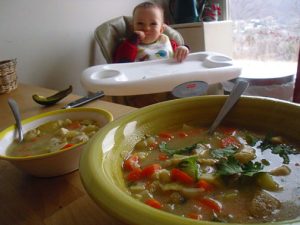
Hearty Fish Stew with Elijah -"I want some!"
 In my article, “Making a Beautiful Meal,” I talk about how the different color combinations of foods can greatly enhance and beautify a meal, making it more attractive and appealing. In this HeARTful Idea, I wanted to expand upon this concept to give you more ideas and inspiration while you’re cooking.
In my article, “Making a Beautiful Meal,” I talk about how the different color combinations of foods can greatly enhance and beautify a meal, making it more attractive and appealing. In this HeARTful Idea, I wanted to expand upon this concept to give you more ideas and inspiration while you’re cooking. A color wheel can be very helpful when you are first learning how complementary colors work. As you can see, orange and blue, green and red, and yellow and purple are all directly across from each other. These colors have the most contrast between them, making the colors stand out. You can use them to create more dramatic presentations in cooking and in art.
A color wheel can be very helpful when you are first learning how complementary colors work. As you can see, orange and blue, green and red, and yellow and purple are all directly across from each other. These colors have the most contrast between them, making the colors stand out. You can use them to create more dramatic presentations in cooking and in art. Red and Green: I can think of many different circumstances where red and green create beautiful meals. There are so many because there are so many green as well as red foods. Here are a few examples I can think of off the top of my head:
Red and Green: I can think of many different circumstances where red and green create beautiful meals. There are so many because there are so many green as well as red foods. Here are a few examples I can think of off the top of my head: